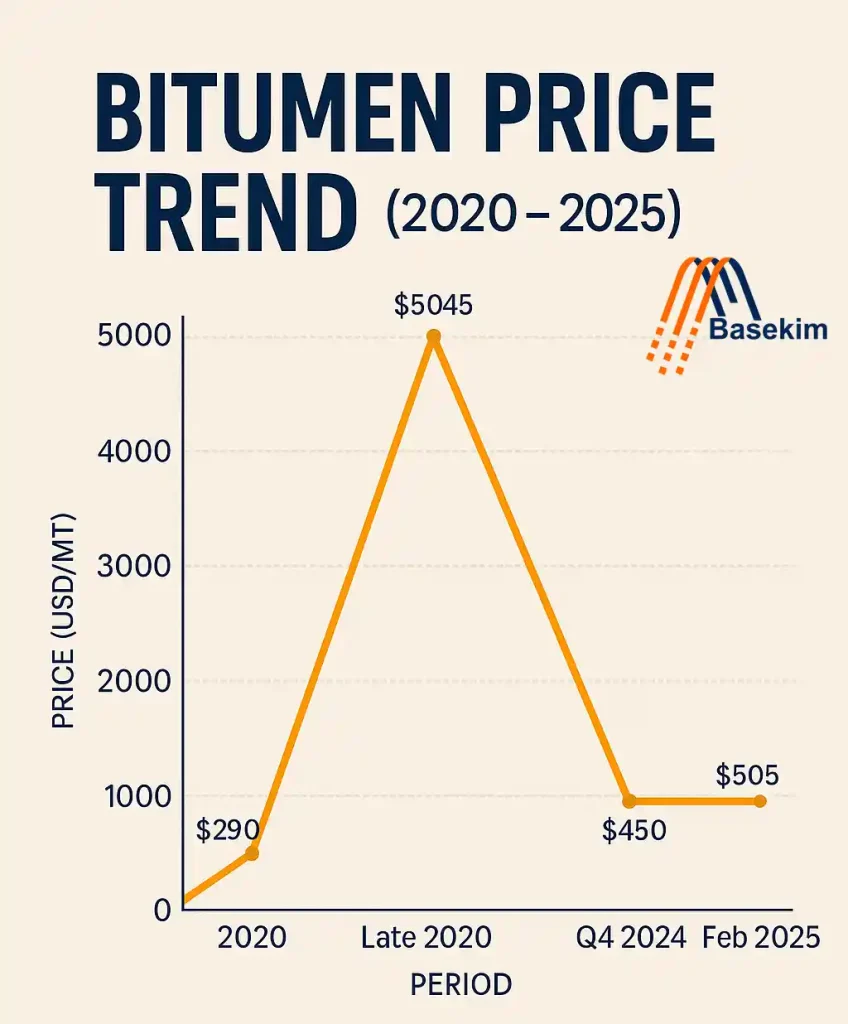
Bitumen is an essential material for infrastructure development worldwide. It is widely used in road construction, roofing, waterproofing, and industrial manufacturing. Because bitumen is a byproduct of crude oil, its price often changes in response to oil market movements. However, over the last few years, bitumen price fluctuations have become more unpredictable.
These changes affect suppliers, contractors, and government projects across Asia, Africa, Europe, and the Middle East. In this report, we will explore the main factors that influence bitumen pricing, regional market trends, and strategies to manage risks.
Why Bitumen Prices Fluctuate
Bitumen pricing is closely tied to the crude oil industry, but it also depends on production costs, transportation, and demand patterns. Here are the key reasons why prices move up or down:
1. Crude Oil Market Changes
Bitumen comes from refining crude oil. When crude oil prices rise sharply, bitumen prices usually increase soon after. For example, a sudden oil price hike due to OPEC production cuts or political tensions can cause bitumen price fluctuations within weeks. Similarly, when oil prices drop, bitumen prices eventually follow, although not always immediately.
2. Shipping and Transportation Costs
Global logistics play a crucial role in final pricing. Bitumen is transported in steel drums, jumbo bags, or bulk tankers. When shipping rates increase, especially through major routes like the Suez Canal or Red Sea, suppliers must raise their prices to cover the extra cost. High freight charges are currently one of the top reasons for unstable bitumen pricing.
3. Seasonal Demand Patterns
Construction projects do not run at the same pace throughout the year. During the dry season, demand for bitumen spikes in regions such as South Asia, East Africa, and the Middle East. As a result, local prices often rise even if global crude oil prices remain stable.
4. Government Regulations
Environmental and quality regulations can also affect production costs. For instance, new rules about sulfur content or eco-friendly processing require refinery upgrades. These changes increase expenses, which suppliers often pass along to buyers.
Regional Bitumen Market Trends
Different regions experience unique price patterns based on production, imports, and infrastructure growth. Understanding these trends is essential for planning purchases.
Middle East
The Middle East is a leading bitumen exporter, with countries like the UAE, Iran, and Saudi Arabia playing a key role.
Strengths: High production capacity, proximity to major shipping routes.
Challenges: Domestic demand is rising, which sometimes limits export availability.
Current Trend: Moderate price increases due to refinery upgrades and shipping costs.
Asia
Asia is the largest bitumen consumer globally, led by India and China.
India: Infrastructure projects, including new highways, create constant demand. Seasonal monsoons disrupt logistics, leading to sudden bitumen price fluctuations.
China: Steady growth, but recent government policies to control emissions have slightly slowed production rates.
Africa
Africa depends heavily on imports because many countries lack refining capacity.
Growing Demand: Road-building programs are expanding rapidly, especially in East Africa and West Africa.
Pricing Pressure: Import reliance and high freight charges often push prices higher. Dubai and Turkey are becoming essential suppliers for African markets.
Europe
Europe has more stable demand, but strict environmental rules increase production costs.
Trend: Gradual, steady price increases rather than sudden jumps.
Focus: High-quality, low-sulfur bitumen grades for advanced projects.
Recent Price Movements
Here is a summary of recent bitumen price fluctuations by region:
| Region | Average Price Range (USD/MT) | Recent Trend |
|---|---|---|
| Middle East | 370 – 420 | Slight upward movement |
| South Asia | 430 – 480 | Sharp seasonal increase |
| East Africa | 450 – 500 | Stable but high freight |
| Southeast Asia | 460 – 510 | Moderate increase |
| Europe | 490 – 530 | Gradual rise |
Prices vary based on grade, packaging, and delivery terms. Bulk shipments generally offer lower unit costs compared to drums or bags.
Forecast for the Coming Months
Industry experts predict that bitumen prices will remain unstable in the short term.
Crude Oil Volatility: Any sudden changes in global oil markets will directly impact bitumen prices.
Freight Costs: Continued congestion in shipping routes may keep logistics expenses high.
Regional Projects: Large-scale infrastructure plans in Africa and Asia are expected to increase demand further.
As a result, buyers should prepare for possible upward movements and secure supply contracts early.
Strategies to Manage Price Risks
Both suppliers and buyers can take steps to handle market uncertainty:
Diversify Supply Sources: Work with multiple suppliers across the UAE, Turkey, and Iran to reduce dependence on one region.
Use Long-Term Contracts: Fixed-price agreements can protect buyers from sudden price hikes.
Plan Purchases Around Seasons: Order early before peak construction months to avoid premium rates.
Optimize Packaging: Bulk deliveries are usually more cost-effective for large projects.
Monitor Market Trends: Regularly track oil prices, shipping updates, and regional demand signals.
Basekim’s Role in a Dynamic Market
As a leading supplier of bitumen and industrial chemicals, Basekim plays a key role in stabilizing supply chains.
Global Presence: With hubs in the UAE, Turkey, and Iran, Basekim serves markets across Asia, Africa, and Europe.
Flexible Packaging: Options include 200 kg steel drums, 50 kg bags, jumbo bags, and bulk shipments.
Market Expertise: The Basekim team closely monitors global trends to help clients navigate bitumen price fluctuations effectively.
By providing reliable products and transparent communication, Basekim ensures that contractors and buyers can plan their projects with confidence.
At the end
The global bitumen market is influenced by crude oil trends, freight costs, environmental regulations, and regional demand cycles. As infrastructure spending grows worldwide, bitumen price fluctuations will remain a challenge for both suppliers and buyers.
To succeed in this competitive environment, businesses must stay informed, plan ahead, and work with trusted partners like Basekim. With the right strategies, companies can secure stable supplies and manage costs even in volatile times.
